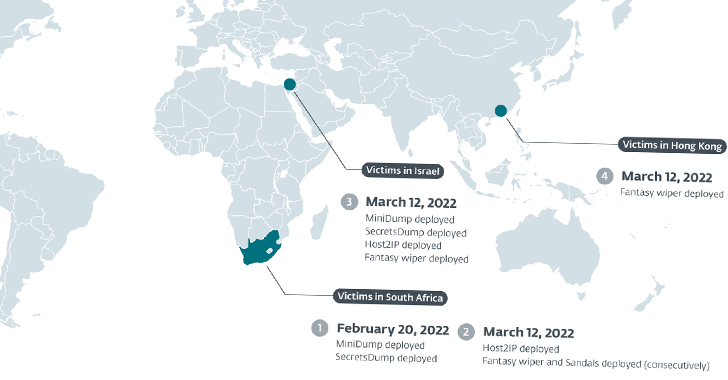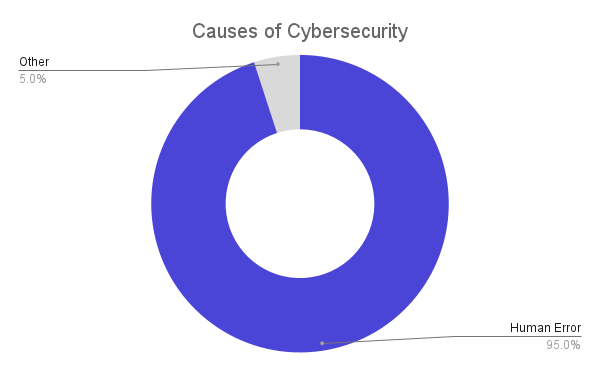The New Age of Diamond Heists: Cyber Security in the Diamond Industry
When you think of stolen diamonds, you likely think of a bank heist or a robber with a balaclava stealing them right out of the store.
Yet in the 21st Century, physical theft is not the only threat to those in the diamond industry. Whatever stage of the diamond trade you’re in, from diamond mining and grading to the diamond cutting industry and distribution, cyber criminals may well be your most significant threat.
If cybercrime were measured as a country, it would be the world’s third-largest economy, with businesses losing $8 trillion globally in 2023.
These cybercrimes can vary greatly, but they most often aim to steal sensitive information that can be exploited. While this data may be sold or used to commit crimes such as bank fraud, it can also be used in other ways.
For example, stolen information could allow hackers to sell sensitive client information such as bank details and addresses, exposing your clients to increased and more sophisticated scams and phishing attempts.
In the UK, around half of businesses of every size report experiencing some form of cyber attack within the last year. With cybercrime being such a prominent issue affecting businesses of all sizes across all industries, maintaining good cyber security should be a top priority for every business, especially those in the lucrative diamond and gemstone industries.
Cyber Crime Affects All, Big and Small
When it comes to cybercrime, no business is safe. Any company that holds sensitive information is a ripe target for criminals. As such, companies of any size from almost any industry are at risk and must invest in cyber security.
Cybersecurity is often associated with major tech companies like Microsoft and Google, and these large organizations are indeed frequent targets. For example, the 2021 attack on Microsoft Exchange email servers impacted 60,000 companies globally, compromising 250,000 servers and affecting millions of individuals.
Yet no industry is safe. Major retailers like Target in the US have been victims of cybercrime, while smaller and medium-sized businesses also suffer.
New technologies also open up new areas of attack. While AI provides many possible benefits for the diamond industry and other industries, it also opens the door to more sophisticated cyber attacks, using AI voices, faces, or automation to cause harm.
For example, in 2024 a Hong Kong financial worker was tricked into sending hackers $25 million of his bank’s money after a fake call with the company’s CFO - who was actually a hacker using AI-generated images and voices to sound and look like the CFO.
How Can Cyber Crime Affect the Diamond Industry?
The diamond industry is not new to cyber attacks.
Diamonds have always been targets for thieves, with recorded targeting of diamonds since the 1960s. Since the internet has become the world’s prevalent platform for everything business-related, the diamond industry has faced the threat of cybercrime.
Despite this, if you’ve not encountered cyber crime in the diamond industry before it can be difficult to imagine how a lack of cyber security can result in the physical theft of diamonds.

What Might A Cyber Attack Against My Diamond Business Look Like?
One good example is a man-in-the-middle attack. If you are a business owner in the diamond industry, you might travel for work - whether to visit new sites, to meet with potential buyers, or for any other reason. While traveling, you may be tempted to access your business email over free airport WiFi - a connection that is weak and can be easily intercepted by attackers.
After intercepting your private information, the attacker could easily email clients from your email address, or change key business data such as shipping details for a shipment. By the time you realize you’ve been hacked, your valuable diamond goods have already arrived at the hacker’s chosen destination, never to be seen again.
Retrieving these stolen diamonds is made even more difficult, given the challenges surrounding traceability in the diamond industry.
The Graff Attack
At the consumer end of the diamond industry supply chain, high-end jeweler Graff fell victim to a ransomware attack in 2021. Being targeted by the Russian hacking group Conti, Graff lost sensitive data for around 11,000 clients.
These clients include many high-profile clients, including royalty, celebrities, and world leaders.
Conti, the cybercriminals, demanded a multi-million-dollar ransom and threatened to release the information if their demands were not met. Not only this, the breach of data security instigated the ICO (the UK’s Information Commissioner's Office) to investigate the incident - a regulator that can fine firms up to 4% of turnover should any clear failures in data security be found.
Iranian Attack
Cyber attacks are not limited to private criminal groups.
A group linked to the Iranian government named Agrius recently carried out a malware attack against a common Israeli software tool in the diamond industry. The attack managed to steal and delete information and infect the systems of at least five other organizations that worked with the target.
These included a jeweler in Hong Kong, a diamond wholesaler, another IT support services provider in Israel, a South African organization from the diamond industry, and an HR consulting firm.

The exact reach of the attack is still unknown, however risk of data theft for all the businesses involved is high.
By stealing sensitive data, Agrius may be able to sell this data to other criminals, facilitating more serious crimes and theft of real diamonds in the future.
Christie’s Auction House Attack
An extremely recent cyber attack, established British auction house Christies which deals in high-end art, antiques, and luxury items like diamonds suffered a data breach in 2024.
Cybercrime group RansomHub reportedly stole the data of 500,000 of Christie's clients, many of whom were high net-worth individuals. The group then demanded an unknown amount of money from Christie’s, stating they were negotiating with the company.
The full damage of this attack remains unknown, but many are wary that the true threat is that the personal information stolen could lead to more sophisticated, targeted attacks against the clients whose data was stolen.
Cyber Attacks - What Are They and What to Look Out For
The first line of defense in your cyber security is understanding what you are up against.
Whether you’re in diamond mining, diamond cutting or manufacturing, or somewhere else in this chain, you probably have already realized just how reliant you and every modern business are on the internet.
From company emails to a business’s bank accounts, cybercriminals can extort your business in many ways, even if your products are primarily physical, as in the diamond industry.
Ultimately, most attacks come down to one thing: getting ransomware into your system, aiming to access private data, take down services, and demand payment for the return of stolen data.
All the Types of Cyber Attacks You Need To Know
Complicated firewalls and dedicated cyber security are great. Still, often the best defense against hacking attacks is understanding the threat, which allows you to spot them before you get caught out.
Here are most of the main types of cyber attacks you and your business are likely to face:
Phishing
One of the most common attacks is phishing, in which attackers trick victims into revealing sensitive information through fake messages. These messages can appear in the form of fraudulent emails, text messages, or websites that appear legitimate.
In fact, email was the most common vector of malware in 2023, and business email compromises led to $2.9 billion in losses.
Malware
Short for malicious software, malware refers to various types of harmful programs, such as viruses, worms, Trojans, and spyware that will infect, infiltrate and damage your computer systems.
These viruses steal data, gain unauthorized access to systems, and can be delivered in many different ways such as phishing attacks.
Data Interception
From opening social media to sending funds through mobile banking, everything you do online requires devices to send data between each other.
This data can be intercepted by cybercriminals, where they intercept and access your sensitive information transmitted between devices or systems.
Man-in-the-middle (MITM) attack
Often included within the area of data interception attacks, man-in-the-middle (MITM) attacks are where an attacker positions themselves between two communicating parties.
By doing this, attackers can eavesdrop, intercept, or even modify the data without your knowledge, allowing them to access and even edit sensitive data such as shipping addresses, banking details, email addresses, and more.
Supply Chain Attacks
Your business is, unfortunately, not the only area of cyber security you have to worry about.
Supply chain attacks target the technology or service providers that are part of an organization's supply chain. By compromising these third-party entities, attackers can access the targeted organization's systems and data.
For example, you may use an external shipping company to distribute your products, whether they be diamonds or equipment related to the industry.
Attackers may decide to target shipping companies, rather than your business directly, from which they can then gain access to sensitive business data.
Social Engineering Attacks
Despite all the cyber security threats that exist, humans are still the weakest link in the chain.
These attacks employ various techniques to deceive individuals into actions that compromise security, such as clicking on malicious links, downloading infected files, or disclosing sensitive information.
Other Kinds of Cyber Threats
Most of the world’s cyber attacks fall into one of the above categories, however there are always other niche threats to protect against.
These can include DDoS attacks, advanced persistent threats (APTs), insider threats, and zero-day vulnerabilities that organizations need to be aware of and prepared to defend against.
How to Stay Protected and Keep Your Diamonds and Business Safe
The importance of good cyber security is clear, especially for a highly targeted sector such as the diamond industry. Yet if you have little experience with firewalls or data protection, it can be hard to know where to start.
Luckily, there are a few key strategies you can carry out to greatly enhance your business’s cyber security, no matter what industry you are in.
Protecting the Human Element With Staff Training
As seen by the data, humans are often the weakest link in the chain.

Because of this, a top priority to protect your diamond business is to bring in regular, and thorough, cyber security training for all your employees — and yourself.
This is especially important if you are a customer-facing business within the diamond industry. For example, if you buy diamonds wholesale and then sell to customers, attackers may target your customer support agents to gain information, helping them then target your business on the wholesale side.
The training should include advice on good cyber security habits, such as best practices for accessing your private information on public WiFi, how to spot phishing attacks, and what questions not to answer when working with customers.
Conducting Consistent Cyber Security Tests
While training your human team is important, ensuring the safety of the software side of your cyber security is just as vital.
Whatever systems you have, conducting regular tests is the best way to stay protected.
Initially, this should include penetration testing, where you employ “good” hackers to attempt to break into your systems, identifying key weaknesses and showing you what areas need more protection.
You should also conduct regular tests of all your systems for malware or viruses, and maintain secure backups for your information to reduce the dangers of ransomware. Alongside this, it’s important that you also regularly update security software such as firewalls or antivirus software to ensure they work correctly at all times.
Verifying All Ends of The Supply Chain
As seen with the Agrius attack on the diamond industry, a single business being infected can affect the entire supply chain.
Unfortunately, this means even if your cyber security is stronger than the Pentagon’s, an attack on one of your partners may still leave you vulnerable. To combat this, you’ll want to ensure your partners maintain good cyber security and be wary of all communications, including those that seemingly come from partners.
Conclusions - Keeping Your Diamonds Safe Both in the Vault and On The Cloud
When your entire business is based on diamonds or precious stones, worrying about cyber security may not be your first priority. At least, not until you discover the potential risks of cyber crime.
With the right strategies, planning, and technology partner, you can swiftly enhance your cybersecurity. No matter your role in the diamond industry, the right technology partner can be essential to keeping your business secure.
For this, look no further than BidGemmer.
BidGemmer provides a secure, reliable platform to support diamond businesses at every stage of the supply chain, enabling customers to focus on growth. From inventory management and customer relationship building to streamlined selling, BidGemmer has everything you need.
Request a Demo today to see how BidGemmer can help you grow your business while staying protected online!
